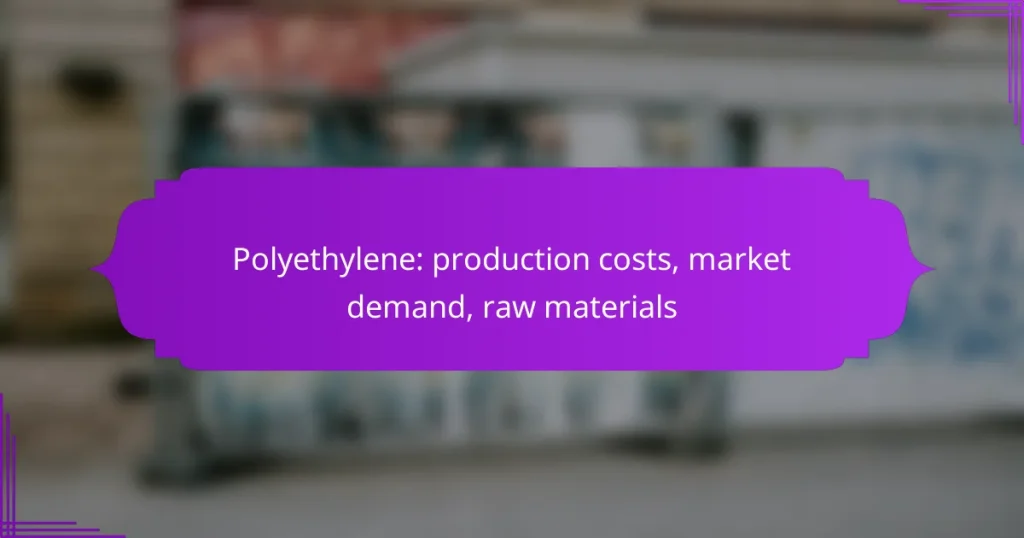Polyethylene production in New Zealand faces moderate to high costs, primarily influenced by raw material prices, energy expenses, and manufacturing techniques. This versatile plastic sees strong market demand across various sectors, including packaging, construction, and automotive, highlighting its essential role in both local production and imports.

What are the production costs of polyethylene in New Zealand?
The production costs of polyethylene in New Zealand typically range from moderate to high, influenced by various factors such as raw material prices, energy costs, and manufacturing processes. Understanding these costs is crucial for manufacturers and investors in the polymer industry.
Cost breakdown by manufacturing process
The main manufacturing processes for polyethylene include polymerization methods like low-density polyethylene (LDPE) and high-density polyethylene (HDPE) production. Each method has distinct cost implications, with LDPE generally being more expensive due to its complex production process. For instance, the costs associated with equipment, labor, and energy consumption can vary significantly between these methods.
Additionally, the choice of catalyst and the scale of production can further influence costs. Larger production facilities often benefit from economies of scale, reducing the per-unit cost of polyethylene.
Factors influencing production costs
Several key factors affect the production costs of polyethylene in New Zealand. Raw material prices, particularly for ethylene derived from natural gas or crude oil, are a primary concern. Fluctuations in global oil prices can directly impact the cost of polyethylene production.
Energy costs also play a significant role, as the production process is energy-intensive. Local energy prices and availability can lead to variations in overall production expenses. Regulatory factors, such as environmental compliance costs, can further influence the financial landscape for polyethylene manufacturers.
Comparison with global production costs
When comparing New Zealand’s polyethylene production costs to global standards, it is evident that local costs can be higher due to limited access to raw materials and energy resources. Countries with abundant fossil fuel reserves often enjoy lower production costs, allowing them to dominate the market.
For example, regions in the Middle East benefit from low-cost natural gas, significantly reducing their polyethylene production expenses. In contrast, New Zealand’s reliance on imported materials can lead to higher prices, making it essential for local producers to optimize their operations to remain competitive.
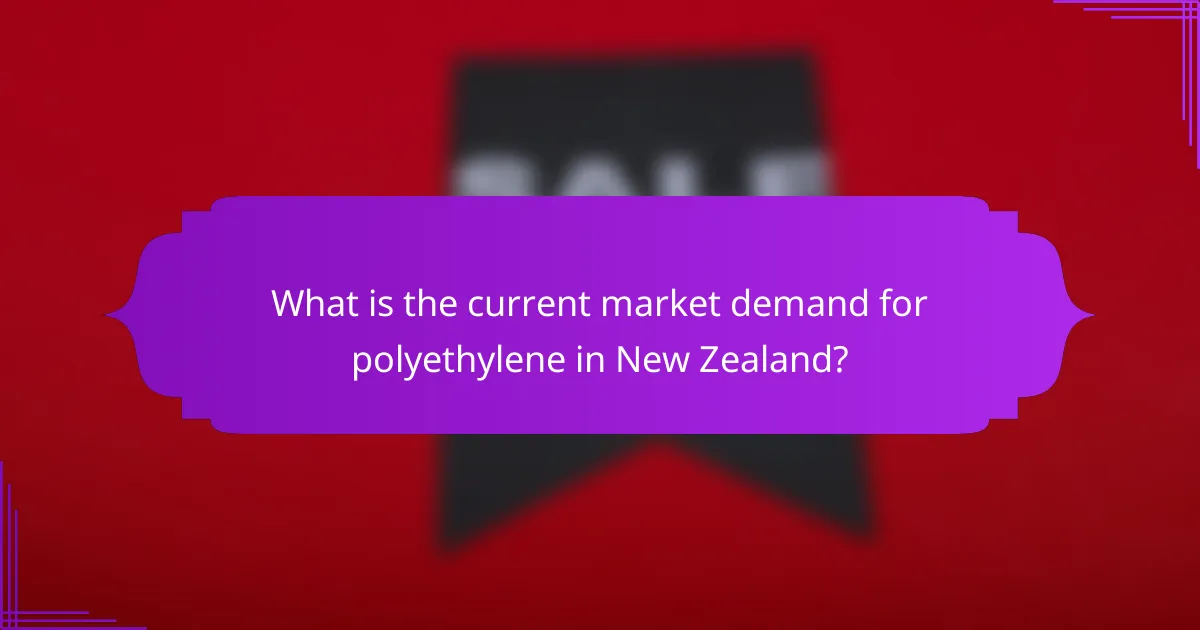
What is the current market demand for polyethylene in New Zealand?
The market demand for polyethylene in New Zealand is robust, driven by various industries that rely on this versatile plastic. As a key material in packaging, construction, and automotive sectors, polyethylene’s consumption continues to grow, reflecting both local production capabilities and import needs.
Trends in polyethylene consumption
In recent years, polyethylene consumption in New Zealand has shown a steady increase, particularly in packaging applications. The shift towards sustainable practices has also influenced demand, with a growing preference for recyclable and biodegradable options. This trend is prompting manufacturers to innovate and adapt their product lines accordingly.
Moreover, the rise of e-commerce has significantly boosted the demand for polyethylene packaging, as businesses seek efficient and protective solutions for shipping products. This trend is expected to continue as online shopping remains popular among consumers.
Key industries driving demand
The packaging industry is the largest consumer of polyethylene in New Zealand, accounting for a significant portion of the total demand. This includes flexible packaging for food products, which is crucial for maintaining freshness and extending shelf life. Additionally, the construction sector utilizes polyethylene for insulation and vapor barriers, contributing to its overall consumption.
Other notable industries include automotive manufacturing, where polyethylene is used for various components due to its lightweight and durable properties. The agricultural sector also plays a role, utilizing polyethylene films for crop protection and greenhouse applications.
Forecast for future demand
The future demand for polyethylene in New Zealand is expected to remain strong, with projections indicating continued growth across key sectors. As sustainability becomes increasingly important, manufacturers are likely to invest in more eco-friendly polyethylene alternatives, which could reshape the market landscape.
Additionally, advancements in recycling technologies may enhance the circular economy for polyethylene, further driving demand. Overall, the combination of industry growth and evolving consumer preferences suggests a positive outlook for polyethylene consumption in the coming years.
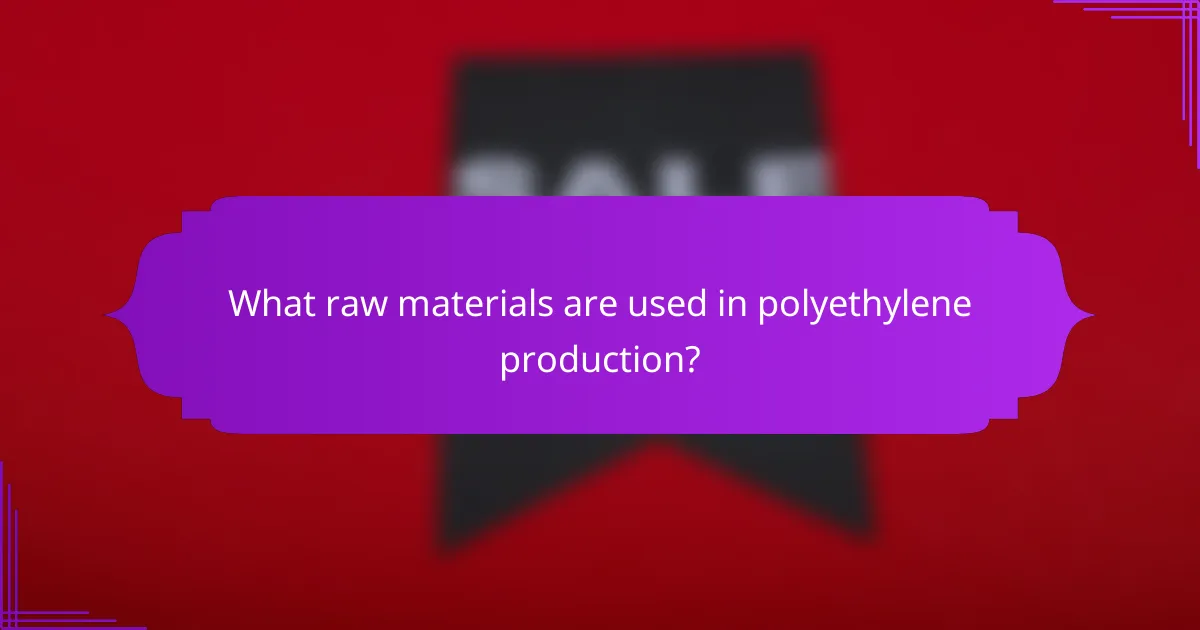
What raw materials are used in polyethylene production?
Polyethylene production primarily relies on ethylene and other hydrocarbons derived from fossil fuels. These raw materials are essential for creating the polymer chains that form polyethylene, which is widely used in various applications.
Primary raw materials required
The main raw material for polyethylene is ethylene, a gaseous hydrocarbon produced from natural gas or crude oil. In addition to ethylene, other materials such as propylene and butylene may be used in specific formulations to enhance properties like flexibility and strength. The choice of raw materials can significantly influence the characteristics of the final product.
Sources of raw materials in New Zealand
In New Zealand, ethylene is primarily sourced from natural gas processing and oil refining. The country has limited domestic production capacity, leading to reliance on imports for some raw materials. Local suppliers often work under strict environmental regulations to ensure sustainable sourcing practices, which can affect availability and pricing.
Impact of raw material prices on production
The prices of raw materials like ethylene can fluctuate significantly due to global market conditions, affecting overall production costs for polyethylene. When raw material prices rise, manufacturers may face tighter profit margins or may need to pass costs onto consumers. Monitoring market trends and establishing long-term contracts can help mitigate these risks and stabilize production expenses.
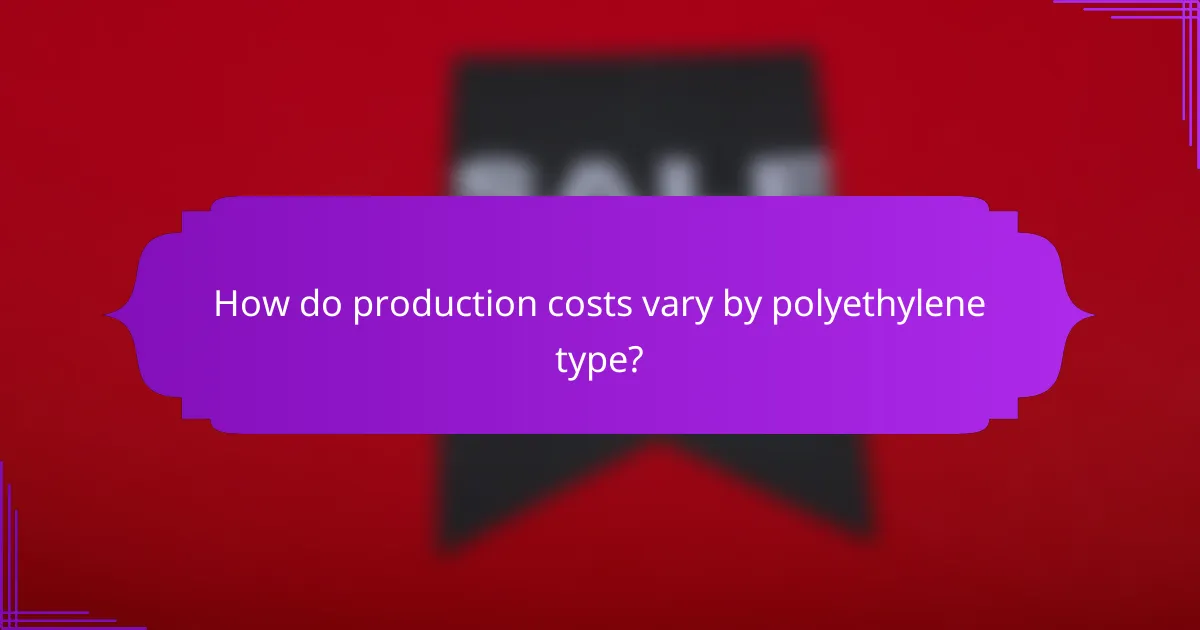
How do production costs vary by polyethylene type?
Production costs for polyethylene types, such as HDPE and LDPE, differ significantly due to variations in raw materials, processing methods, and market demand. Understanding these differences is crucial for manufacturers and buyers to make informed decisions regarding pricing and sourcing.
Differences between HDPE and LDPE costs
HDPE (High-Density Polyethylene) generally has higher production costs compared to LDPE (Low-Density Polyethylene) due to its more complex processing requirements and the need for higher temperatures during production. The raw materials used for HDPE are often more expensive, contributing to the overall cost disparity.
In practical terms, HDPE is typically favored for applications requiring greater strength and durability, such as containers and piping, while LDPE is preferred for flexible applications like plastic bags. This distinction can influence pricing strategies based on the intended use of the polyethylene.
Market pricing for different polyethylene grades
Market pricing for polyethylene grades varies widely based on factors such as supply and demand, production costs, and global economic conditions. As of recent trends, HDPE prices can range from the low to mid hundreds of USD per ton, while LDPE prices are often slightly lower, reflecting their different applications and production complexities.
Additionally, specialty grades of polyethylene, such as those used for medical or food packaging, may command premium prices due to stricter regulatory requirements and higher quality standards. Buyers should stay informed about market fluctuations to optimize their purchasing decisions.

What are the environmental impacts of polyethylene production?
The production of polyethylene has significant environmental impacts, primarily due to greenhouse gas emissions and resource consumption. The processes involved in manufacturing polyethylene contribute to air pollution and deplete natural resources, raising concerns about sustainability and ecological balance.
Carbon footprint of polyethylene manufacturing
The carbon footprint of polyethylene manufacturing is substantial, largely due to the fossil fuels used in production. Estimates suggest that producing one ton of polyethylene can emit several tons of carbon dioxide, depending on the energy sources utilized. Transitioning to renewable energy sources can help reduce these emissions significantly.
Manufacturers are increasingly adopting cleaner technologies and practices to lower their carbon footprint. For instance, using natural gas instead of coal can cut emissions by a notable percentage. Companies are also exploring carbon capture and storage solutions to mitigate their environmental impact.
Recycling rates and sustainability efforts
Recycling rates for polyethylene remain relatively low, with estimates often falling below 20% globally. This low rate is attributed to challenges in collection, sorting, and processing of polyethylene waste. However, there are ongoing efforts to improve these rates through better recycling technologies and public awareness campaigns.
Many companies are committing to sustainability initiatives, such as using recycled materials in their products and investing in advanced recycling methods. Some regions have implemented regulations to promote recycling and reduce plastic waste, encouraging manufacturers to adopt more sustainable practices.
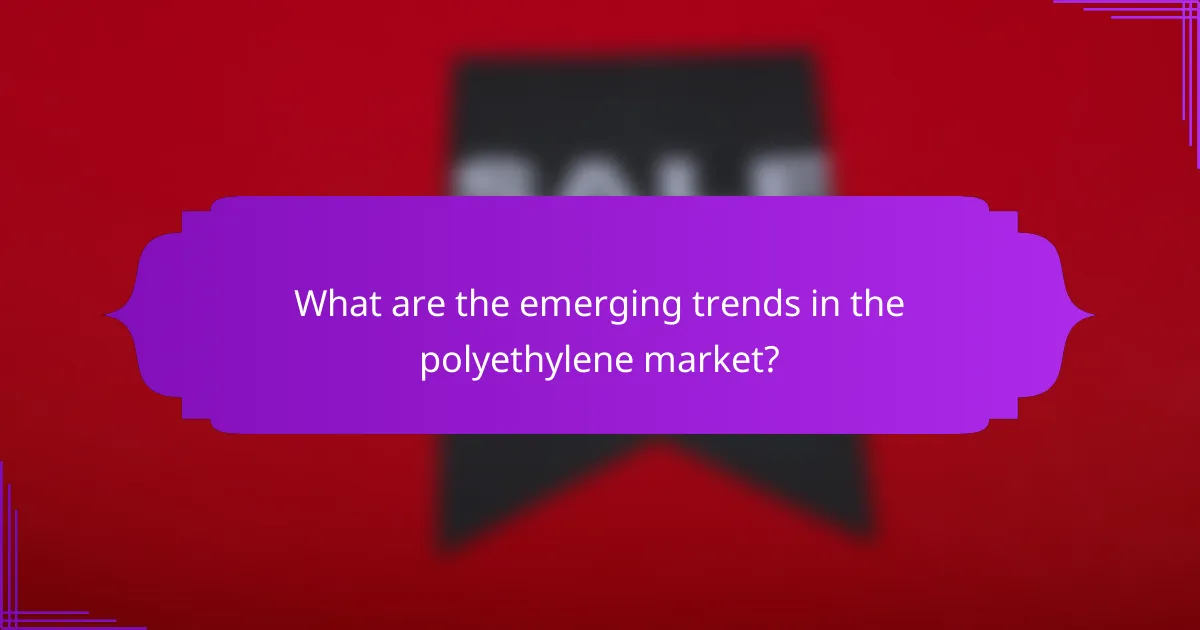
What are the emerging trends in the polyethylene market?
The polyethylene market is currently experiencing significant shifts driven by technological advancements, sustainability initiatives, and regulatory changes. These trends are reshaping production methods, influencing consumer preferences, and altering the competitive landscape.
Innovations in production technology
Recent innovations in polyethylene production technology focus on enhancing efficiency and reducing costs. Techniques such as advanced catalytic processes and improved polymerization methods are being adopted to create higher-quality products with lower energy consumption.
For instance, the use of digital technologies and automation in manufacturing processes is streamlining operations, leading to faster production times and reduced waste. Companies are increasingly investing in research and development to stay competitive in this evolving market.
Shifts towards bioplastics
There is a growing trend towards bioplastics as consumers and manufacturers seek more sustainable alternatives to traditional polyethylene. Bioplastics, derived from renewable resources, are gaining traction due to their lower environmental impact and biodegradability.
Many companies are now exploring the integration of bioplastics into their product lines, responding to consumer demand for eco-friendly options. This shift not only aligns with sustainability goals but also opens new market opportunities for businesses willing to innovate.
Regulatory changes affecting the industry
Regulatory changes are significantly impacting the polyethylene industry, particularly regarding environmental standards and waste management. Governments worldwide are implementing stricter regulations to reduce plastic pollution, which is prompting manufacturers to adapt their practices.
For example, the European Union has introduced directives aimed at reducing single-use plastics, pushing companies to explore alternative materials and enhance recycling efforts. Staying informed about these regulations is crucial for businesses to ensure compliance and maintain market access.
